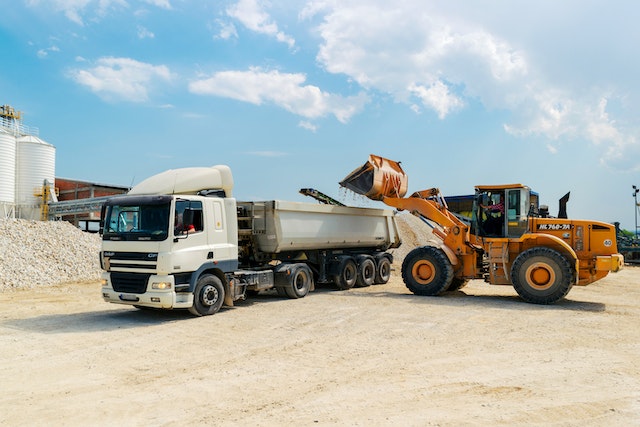
What is a Dumper Truck? A Dumper Truck, commonly referred to as a ‘Site Dumper’ within the Construction Industry, is a vehicle principally designed for carrying materials on construction sites. They are part of a broader group of construction work related equipment referred to as ‘mobile plant.’ Our article reviews a range of health and safety issues, and provides essential Dumper Truck safety guidance for Construction businesses.
Dumper Truck Safety | Types of Dumper Trucks
The phrase Dumper Truck is a generic term for a variety of vehicles commonly used in construction site and include:
- Rigid Dumper Trucks –These trucks are used for larger loads and are particularly good for construction projects because they’re durable and yet fast. This makes getting between construction sites and materials yards fairly comfortably. However, they usually only operate on the open roads since they aren’t that manoeuvrable in confined spaces.
- Articulated Dumper trucks – Articulated dumper trucks principally are used to transport materials to required locations within sites that has been delivered on delivery vehicles e.g., Rigid Dumper Trucks. These types of trucks are particularly useful to work in rough terrain in construction sites but are not suited to large loads and require highly skilled operatives, so a person is very unlikely to be hired to drive these without recognised professional competence-based training.
- Tracked Dumper Trucks – Tracked dumper trucks are ideal for rough terrain and difficult weather conditions, so you will see them on construction sites in any scenario. They’re heavily favoured in first stage groundworks and have a secondary benefit creating a safer surface for other site mobile plant by flattening ground.
- Mini Dumper Trucks – Mini dumper trucks are basically smaller versions of all of the above vehicles and can be hired by any person who holds a category B licence. However, they do come in different weights and sizes for varying types of projects which will need different categories of licenses. Fairly easy to use when being operated safely and responsibly and are particularly useful in small construction related activities e.g., single house building projects and gardening/landscaping projects.
How do I Manage Dumper Truck Safety?
Sadly, site dumpers are involved in approximately a third of all construction transport accidnets resulting in many fatalities and serious injuries mainly to the drivers. The most common causes of these accidents are:
- Overturning on slopes and rough ground and at the edges of embankments and excavations etc.,
- Travelling when a high-lift skip is in the raised position.
- Pedestrian/vehicular conflict i.e. incidents where a pedestrian is run over by the wheels of the dumper.
- Drivers thrown from the vehicle while driving over rough terrain; and
- Driver error due to lack of experience and suitable training.
The Legal Requirements
The principal responsibility holders are hire companies and users of the equipment whose aim is to prevent accidents. Broadly speaking, all work equipment including site dumpers should be safe when supplied and the risks arising from their use are to be controlled. Those in control of the work involving site dumpers have a legal duty to assess risk, plan and implement safe systems of work, ensure drivers and other workers on site know what they are and follow them refraining from taking short cuts. Work activities and safe sytems should also be monitored by Site Managers.
Site Management Safety
An effectively managed site will help reduce incidents involving site dumpers. To help ensure sites are safe, traffic routes used by site dumpers should incorporate the following:
- Effective maintenance of routes to minimise potholes, rut’s, debris and other obstructions.
- Avoid routes that have slopes where possible, if they cannot be avoided then as an operator (Site Manager) of site dumpers you must check (as part of the risk assessement process) with the vehicle supplier that it can negotiate slopes safely.
- When a site dumper overturns, it is generally as a result of a combination of both slope and rough ground, therefore the maufacturers guidance on the capability of the site dumper to negatiate a slope should be reduced where rough ground has to be negotiated.
- Speed can also be a contributing factor in overturning, so should be kept to a minimum generally, especially on rough ground.
- In areas where traffic routes pass close to the edge of excavations, embankments or other drops, the edge of the roadway must be supported to prevent vehicles running off the roadway.
- To prevent site dumpers overturning during tipping manoeuvres, stop blocks can be positioned a safe distance from the edges of excavations, pits and spoil heaps etc..
- With high-lift skip dumpers, their stability is greatly reduced when in the elevated position. This means that the ground has to be suitably flat, level and free of any debris at locations where these type of dumpers require their skips to be raised e.g., when they need to tip waste into a waste container.
- Vehicular/pedestrian conflict (where site dumpers are used in the vicinity of people) is a significant hazard that needs to be closely considered especially when evaluating suitable risk control measures. Pedestrians and any site vehicles including site dumpers should be kept apart whenever possible by providing ‘pedestrian only’ routes. In circumstances where pedestrians and vehicles have to share the same route, segregated walkways alongside the vehicle route need to be considered. The HSE provide guidance relating to workplace transport and the INDG148 Reversing Vehicles leaflet.
- Site dumpers should not be loaded to a level that would prevent the driver from safely seeing the route ahead in the direction of travel.
Site Managers and others responsible for site monitoring activites should always make regular checks to ensure that safety procedures, precautions and controls are in place, effective and being adhered to.
Vehicle Safety
What do I need to consider when selecting the right site dumper?
For those who will be using dumper trucks i.e. Site and Project Managers etc. you must ensure that site dumpers a capable of performing the tasks they are expected to undertake. This would include the size and capacity of the dumper e.g. a dumper that is too small is likely to be overloaded and this will increase the risk of overturning and reduce the ability to stop safely. A dumper that is bigger than is necessary can become more difficult to manoeuvre safely and may reduce the drivers vision.
It is important to select dumpers that are sufficiently stable in all site conditions. If narrow track or high-lift dumpers are required then their stability needs to be carefully assessed. On sites where there is significant slopes or poor ground conditions then consider alternative types of dumpers e.g.. tracked dumpers.
Dumper Truck Safety & Driver Protection
All new site dumpers are provided with roll-over protection structures (ROPS) and seat restraints e.g. seat belts, these are essential protection devices to protect the drivers from risks of site dumpers rolling over. The correct use of seat restraints is an essential part of the ROPS protection system and is designed to hold the driver in position if the vehicle rolls over.
It must not be assumed a ROPS bar it’s on, will fully protect the driver in the event of a roll-over. It’s common for drivers to instinctively try and jump clear of a vehicle as it rolls, but this has found to be only partially successful and can suffer serious injuries from being trapped by the dumper when it comes to rest. It is safer to be held by the seat belt within the area protected by the ROPS. There has been roll-over occurrences investigated by HSE Enforcements Offciers that have found drivers have walked away without injury when the drivers were wearing their seat belts. (HSE guidance – MISC175 Retrofitting of roll-over protective structures, restraining systems and attachment points to mobile work equipment Information Sheet.)
What if our site dumper cannot pass through a doorway or other other opening due to the ROPS bar?
The bar may be folded down if the site dumper has to pass through on a frequent basis, but it must replaced to its normal postion as soon as is practicable when the work in these areas is complete and properly locked into postion.
Dumper Truck Safety | Maintenance
As with any item of work equipment, site dumpers must maintained in a safe state, serviced and inspected as recommeded by the manufacturer and in accordance with relevant legisaltion. In support of this there must be an effective system for reporting defects to enable the necessary corrective action to be taken and a suitable vehicle log that recorods maintenace, repairs and inpsections.
Security
All vehicles must be securely immobilised whenever sites are unoccupied. There has been incident where members of the public have trespassed onto sites and operated plant often causing thousands of pounds of damange and occasionally resulting in people being injured.
Drivers & Training Requirements
A contributing factor in many accidents involving mobile plant on sites is untrained and inexperienced drivers and in some cases unauthorised drivers. It is important therefore that only those that are authorised to do so and are competent i.e., possess the necessary skills, knowledge and experience should be permitted to operate any mobile plant including site dumpers.
The Health and Safety Executive (HSE) have published guidance on the training requirements and will seek evidence of training provided i.e. certification, during routine site visits. (HSG144 Safe use of vehicles on constuction sites: A guide for clients, designers, contractors, managers and site operatives involved with mobile plant on construction sites.)
Relative further reading and Guidance
- HSG136 (second Edition) Workplace transport safety: An employers guide.
- MISC156 Hiring and leasing out of plant: Application of PUWER 98, regulations 26 & 27 Information Sheet.
- HSG150 (Third Edition) Health and Safety in Construction.
Put safety first in your business, speak to one of our Health and Safety Consultants for expert tailor-made advice and support you can trust.





